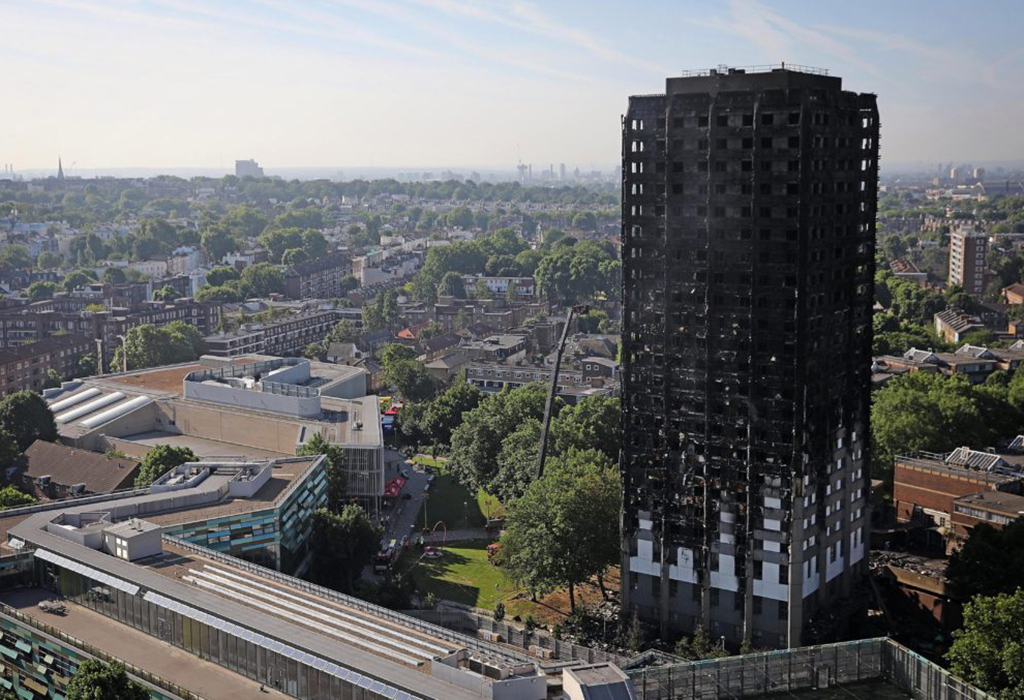Grenfell Tower fire: a year later

By the time the sun began to rise, Grenfell Tower in North Kensington was already a blackened shell. The fire had started shortly before 1am on June 14, when a faulty refrigerator exploded in a flat on the fourth floor of the 24-storey building. Shortly after, despite firefighters arriving within six minutes, the fire had spread out of control, swept up the building’s exterior and invaded many of the 120 flats. In only 21 minutes, the blaze had spread from the fourth floor up 19 storeys. By 4am, the entire 70-metre-high tower was engulfed in flames.
In total, 223 people escaped the fire that night. Several months later – most of the bodies were too badly incinerated to be identified – it was also clear that 70 people had died and another 70 had been injured during the night. The 71st victim, baby Logan, was stillborn a few hours after his parents had escaped the flames. Pily Burton, rescued from her flat on the 19th floor, died seven months later. It became the UK’s deadliest blaze since the Second World War.
In the aftermath, the leader of the Royal Borough of Kensington & Chelsea council, Nicholas Paget-Brown, resigned. Later investigations would show that the fire was exacerbated by flammable cladding installed during a recent renovation, saving £300,000. The £10m cladding scheme was supposed to make the block look more attractive. In the end, it turned out to be a death trap.
However, Grenfell is more than just a story of negligence and greed. It’s also an awful fable of our time. After the fire, many started murmuring what John McDonnell, the current Shadow Chancellor of the Exchequer, later made explicit – that the 72 victims of Grenfell “were murdered by political decisions that were taken over recent decades”. It has also been described as a “Hurricane Katrina moment,” a catastrophe that exposes a rich country’s contempt for its poor. Grenfell quickly became a symbol of the inequalities of Britain while Kensington and Chelsea became a symbol of polarisation – with its poor north and rich south. Today, one year on, that is still the case. And there still remains a disturbing feeling that justice is far from being delivered.
Official investigations have made slow progress. A review of building regulators produced cautious recommendations last month and didn’t prohibit the use of combustible materials. A criminal investigation, which is considering personal and corporate manslaughter charges, will probably not conclude earlier than 2019. London’s fire brigade is facing a police investigation into its “stay put” policy that resulted in residents being told to remain inside their homes as the tower block blazed. The ongoing public inquiry, which is expected to finish in October, is to decide, alongside the police and courts, where the blame lies. The fire service; Kensington and Chelsea council and tenant management organisation; the contractors and manufacturers involved in the refurbishment; safety inspectors; ministers who oversaw the weakening of regulations over several decades: they all played a role. Meanwhile, today 129 of the 210 households that survived the fire are still in temporary accommodation or hotels. Some 11,000 people may also end up suffering from mental health issues, estimates the NHS.
However, we can’t say that we weren’t warned. In fact, the whole disaster could have been avoided. Seven months before the fire, Grenfell Action Group warned that “only an incident that results in serious loss of life… will allow the external scrutiny to occur that will shine a light on… the malign governance of this non-functioning [tenant management organisation].” Residents raised fears with KCTMO about the fact that there was only one escape route. They also told the organisation of their concerns over the absence of a building-wide fire alarm or sprinkler system. What happened later, we all know by now.
One year on, the disaster has come to represent everything that’s unpleasant about the British capital and the political and economic forces that shape it. A lot went wrong up until that day in June, and a lot has gone wrong since then. But the 72 residents can’t have died for nothing, so this first anniversary is important to remember. The Grenfell fire was a tragedy that should never have happened — and we all have to make sure that it will never be forgotten.